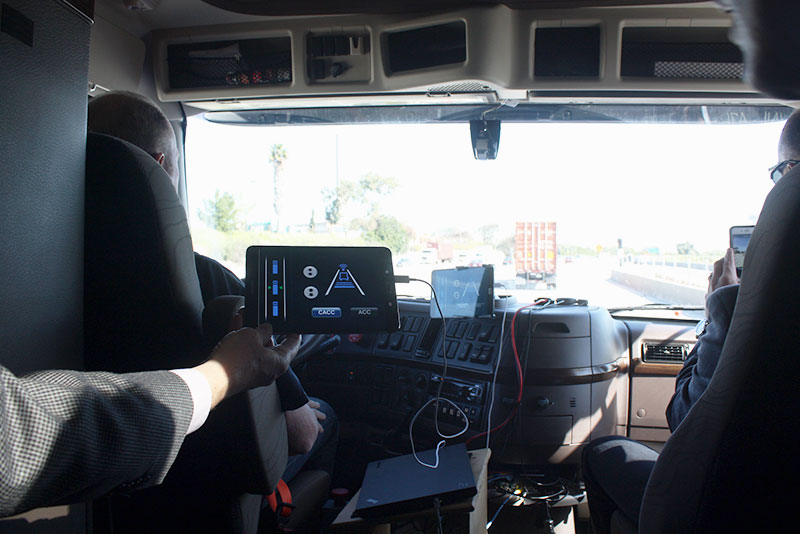The convoy of three Volvo semi-trucks zipping along Southern California’s busy 110 Freeway hauling cargo containers looked like other big rigs that ply that busy stretch of highway daily — except that they were only 50 feet apart and there were robots controlling the pedals in two of the vehicles.
The journey Wednesday was a joint demonstration of truck platoon technology by the California Department of Transportation, local agencies, Volvo Group of North America and U.C. Berkeley.
So-called platoon technology allows tightly contained, digitally connected packs of two to five trucks to drive in formation to reduce wind resistance and increase fuel efficiency. The pack can be controlled by a “captain” in the cab of the front vehicle, with the rest following with their own drivers or eventually, autonomously.
In this test, a driver controlled the first truck while drivers in the second two sat back and let computers and sensors control the speed and separation of their vehicles.
“If you’re comfortable with the driver in front of you, it’s no problem,” said Mike Lackey, a U.C. Berkeley equipment driver.
Lackey sat at the controls of the second truck in the convoy but left them untouched except for guiding his Volvo rig onto streets and back to the freeway at the turnaround point of the 12- mile test.
Once he set the separation distance between the lead truck, software took over to automatically hold the position. If the lead truck drifted ahead, Lackey’s Volvo accelerated. When the truck in front slowed, Lackey’s braked.
“It does take a little getting used to,” Lackey said.
At the test speed of 55 mph, the driver can choose from four following distances, ranging from 0.6 seconds to 1.5 seconds behind.
“Our technology planning and traffic simulation work suggests connected vehicle and truck platooning technologies may eventually facilitate the ability to operate up to 50 percent more trucks on these lanes – essentially giving the capacity equivalent of a third lane of freeway in each direction,” said Mark Jensen, a principal at Cambridge Systematics, which helped develop the cooperative adaptive cruise control system that controls the following distances of the trucks.
Although this was just a demonstration and there are still technical and regulatory hurdles to overcome before truck platooning becomes common, such systems “can improve traffic flow and safety while reducing costs for the freight community,” said Butch Waidelich, acting deputy administrator of the Federal Highway Administration.
The federal agency is studying the potential benefits. It released a feasibility study of driver assistive truck platooning last year that concluded that the technology is near market-ready.
The truck that drove Lackey carries state-of-the-art technology developed in tandem by Volvo Group and California PATH, or Partners for Advanced Transportation Technology at U.C. Berkeley. Volvo supplies the vehicles and an on-site engineer to work with PATH researchers on the technology.

Mike Lackey, a U.C. Berkeley equipment driver, in the cab of the second truck in the platoon convoy. (Photo: Ryan ZumMallen/Trucks.com)
Trucking industry and transportation officials see platooning as the first step in the roll-out of self-driving trucks. They believe such systems could be particularly valuable in areas along the heavily travelled 110 Freeway near the ports of Los Angeles and Long Beach, improving safety and cutting diesel emissions pollution from container-hauling trucks.
“Through the use of vehicle-to-vehicle communication, platooning reduces the reaction time for braking and aerodynamic drag between vehicles, thereby improving safety and fuel economy,” said Susan Alt, a Volvo spokeswoman. “California faces some of the worst traffic congestion in the nation, a contributing factor in the state’s air quality problems.”
More tests are planned.
PATH will test truck driver preferences among multiple following distances on San Francisco Bay Area freeways this spring. More tests will be done on Long Beach area freeways to simulate the impacts of truck platooning on traffic and estimate fuel savings.
“This technology will become available for use in the coming years, and when it does it should be embraced due to its numerous benefits,” said Steven Shladover, program manager of California PATH.
Others are working on similar technology.
Last month, Chicago truck fleet services company Omnitracs formed a partnership with platoon system developer Peloton Technology of Mountain View, Calif., to provide platooning systems that will eventually allow Omnitracs’ customers to run small, partly automated truck convoys. Peloton said its system has undergone more than 15,000 miles of testing.
The U.S. Army conducted a test in live traffic on a Michigan highway in June.
The Netherlands initiated a European Truck Platooning Challenge last year that demonstrated platooning on public roads by six makers of automated trucks — DAF Trucks, Daimler Trucks, Iveco, MAN Truck & Bus, Scania and Volvo Group. The vehicles travelled from several European cities to the Netherlands.
But some aren’t sold on the idea. Missouri Gov. Jay Nixon vetoed a bill last year that would have made platoon testing possible in the state.
Others are concerned that trucking jobs will be replaced by autonomous technology. Dangerous conditions such as inclement weather and shifting loads are best handled by skilled professionals rather than technology, said Kara Deniz, spokeswoman for the Teamsters union.
“We appreciate the role of technology, such as automated braking and electronic stability control, in enhancing safety for our members,” Deniz told Trucks.com. “We believe, however, the risk to the driving public from autonomous technology is compounded in a platooning scenario.”
Engineers at Volvo and California PATH said that their platooning technology is an automated feature that can be disengaged. And since driver input is needed, platooning does not make the truck an autonomous vehicle.
But if platooning does evolve to incorporate driverless trucking, companies may seize the opportunity to safely move more freight with fewer drivers, said James Hedlund, a safety consultant and former associate administrator at the National Highway Traffic Safety Administration.
“I see real advantages there,” Hedlund said.
Source: Trucks
